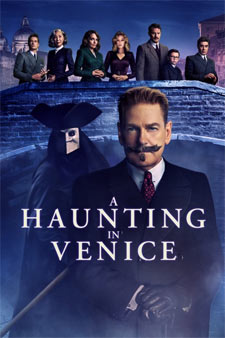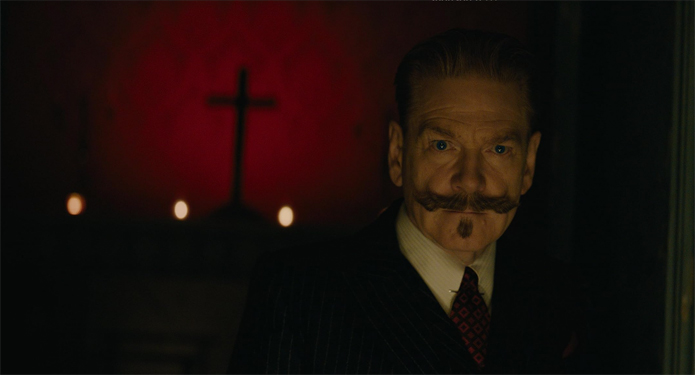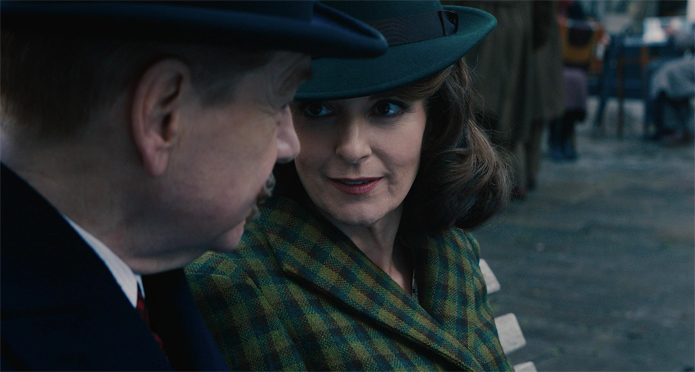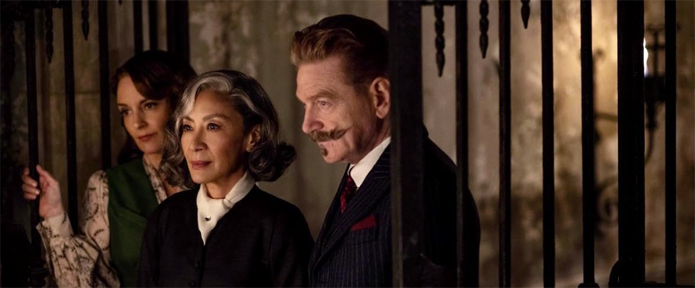
A Haunting in Venice

 – or some strong violence, disturbing images and thematic elements.
– or some strong violence, disturbing images and thematic elements.
Director: Kenneth Branagh
Starring: Kenneth Branagh, Michelle Yeoh, Tina Fey, Jamie Dornan
Running Time: 1 hour, 43 minutes
Theatrical Release Date: September 15, 2023
Digital Release Date: October 31, 2023
Plot Summary
In post-World War II Venice, Poirot, now retired and living in his own exile, reluctantly attends a seance. But when one of the guests is murdered, it is up to the former detective to once again uncover the killer. (from IMDB)
Film Review
Just last year, the first sequel to Kenneth Branaugh’s Hercule Poirot series, Death on the Nile was released following many COVID-inspired delays. And just over a year and a half later, Branaugh is back with his third outing as the famed Agatha Christie sleuth, in the genre mash-up, A Haunting in Venice. The movie is the first film based on Christie’s 1969 novel, “Hallowe’en Party,” and moves the story’s setting from the UK to Venice. I’m glad Branaugh did, too, because the gorgeous setting of Venice is one of the film’s charms. While Death on the Nile painfully relied on green screen special effects to transport audiences to a less-than-realistic version of Egypt, A Haunting in Venice is Branaugh’s most tactile and grounded Poirot entry to date.

A Haunting in Venice is easily the best of the Poirot trilogy, too. Set almost entirely inside a home in Venice, there’s a claustrophobic nature to the story that adds to the tension. 2017’s Murder on the Orient Express confined most of the story to a train, while last year’s Death on the Nile was mostly set on a river boat. Still, both stories managed to break out from their confines at some point. A Haunting in Venice‘s “haunted house” aspect keeps the story close and tight. I’m not one for horror movies – especially supernatural ones (of a serious note, that is. Ghostbusters is more comedic than exclusively supernatural in nature) – but since I knew this would be primarily an Agatha Christie murder mystery, it was a hard one to pass up. Sure enough, the plot revolves around an acquaintance of Poirot’s who encourages him to attend a seance led by a popular medium who is suspected of being a fraud. Poirot, although intrigued, goes reluctanctly, hoping to prove the world of the supernatural to be nothing but fantasy. The story meets him about halfway, leaving it up to interpretation, but those hoping to see a classic “whodunnit?” mystery will leave more satisfied than those hoping for a full-on horror movie.
In fact, the scariest thing about A Haunting in Venice is its trailer. There’s certainly a creepy factor throughout the movie, but the scariest moments are by far the ones you see in the movie’s trailer. A Haunting in Venice is, first and foremost, a murder mystery.

With that said, I found myself grinning like an idiot through a good chunk of A Haunting in Venice. Sure, I think I was just partly relieved that the movie wasn’t really a horror movie (and, in full disclosure, our stupid theater put The Nun 2 on first by accident instead of this movie, so I think I was also just relieved that nightmare didn’t proceed too far), but the DNA of A Haunting in Venice harkens back to the age of classic cinema where horror was more about what you don’t see than what you do see. (I wonder if, at any point in the movie’s production, Branaugh ever considered making this movie entirely in black-and-white?) Furthermore, the actors’ performances make everything come together really well. Comedic actress Tina Fey is a surprise as a somewhat sassy author who assists Poirot during the investigation. Academy Award winner Michelle Yeoh plays the seance medium who offers a great performance, as well as one of the creepiest moments in the movie. And Jamie Dornan plays a war veteran doctor who struggles with PTSD. Branaugh leaves enough clues sprinkled throughout the story to allow viewers to make some guesses along the way, but the movie still manages to surprise – especially if you’re certain you’ve worked it all out.
Branaugh’s direction takes on a different tone for A Haunting in Venice, too. His previous two movies had moments of goofiness or silliness, which allowed the story some lightness when it needed it. Sadly, it didn’t always work well with the story’s tone, so the fact that Venice plays it mostly straight works complements the intended serious tone. Branaugh also uses the camera in unique ways to instill a sense of uneasiness in the audience. It ends up making the movie more visually interesting, too.
The content for A Haunting in Venice is definitely PG-13, with some semi-gruesome visuals included, even if they aren’t especially graphic in detail. For example, a character is seen falling and being impaled on the arm of a statue, but it’s shown happening in shadow on a wall. We then see the body hanging from the statue with the hand sticking out, but it’s dimly lit, so we don’t see anything particularly graphic (other than the obvious impalement). Another scene shows a person being stabbed in the back, and it’s shown in a way that isn’t bloody or graphic, but you can still “feel” it by the way the knife is shown disappearing into the character’s body. Other characters are shown drowning or struggling in water, and we see a creepy view of a water-logged ghostly girl reflecting in a mirror. A sequence during the seance shows Yeoh’s character thrashing about dramatically and pawing at her face in a way that is a little disturbing, but it ends up not really being anything substantial. There’s very little profanity in the movie, but there’s at least one “S” word, a couple uses of “h*ll” and “d*mn” and 2 uses of “Chr-st.” A Haunting in Venice isn’t especially frightening, but it is definitely spooky, and I can see this being one worth revisiting in October around Halloween. (It does take place around Halloween, too.)

If you’re concerned about the spiritual aspects of the story, I’ll share some SPOILERS here in this paragraph for anyone interested. Again, be warned, this paragraph contains spoilers! Poirot makes it clear that he doesn’t believe in the supernatural and feels that if ghosts exist, it would prove the existence of God (of whom he also doesn’t believe in). The seance scene offers the stereotypical ghostly happenings, but Poirot quickly exposes them as fraudulent. The seance medium experiences a violent moment of being spun in her chair, which is intended to make everyone believe something sinister is happening. We soon learn that, too, was faked. Poirot then starts seeing ghostly imagery or hearing unexplainable sounds, but we later learn they were hallucinations. The finale sort of hints that a victim’s ghost may have helped in knocking the killer off a ledge to their death, but we never know for sure if it was just a hallucination or the real thing, ultimately leaving it up to the viewer’s interpretation. I don’t love the fact that Poirot doesn’t believe in God, but I did enjoy seeing him discredit the psychic. And, in the end, Poirot seems to have rediscovered his purpose in life after having kind of retired from sleuthing. (OK, End of Spoilers!)
If you like murder mysteries and Kenneth Branaugh’s take on Hercule Poirot, A Haunting in Venice is the best in his series so far. It definitely has some creepy and spooky moments – as well as violent ones – so I wouldn’t recommend it for all ages. But if you can take a little spookiness with your mysteries, A Haunting in Venice is an excellent choice, and one of the better entries of its kind I’ve seen in a while.
– John DiBiase (reviewed: 9/20/23)
iTunes / Digital Copy Bonus Features
Just in time for Halloween – on which this movie’s story begins – A Haunting in Venice has found its way to streaming services. The special features on the iTunes digital copy include:
A Haunting in Venice in Digital 4K – I saw the latest Hercule Poirot case on IMAX in September, so this is the second time I’m seeing A Haunting in Venice, which was based on the Agatha Christie novel, Hallowe’en Party. I have to honestly say it looks quite excellent in 4K digitally. I’m pretty picky about 4K – especially presented digitally (I find that on-disc 4K looks the best) – but A Haunting in Venice looks quite excellent in the crisp presentation of 4K. Also, I can’t help it; I kinda love this movie. It just really captures that black-and-white “whodunnit?” mystery element from the golden years of cinema. I love old movies, and A Haunting in Venice feels – to me – like an old movie. The performances in this movie are fantastic, too, which only makes it a stronger production as a whole. While this movie completes a Poirot trilogy, I’d kind of like to see Kenneth Branagh continue to reprise Poirot for more Christie-penned stories in the near future.
Murder, Death, and Haunting (26:09) – This featurette is a cleverly titled documentary that takes a look at bringing Kenneth Branagh’s trilogy of Hercule Poirot mystery stories to the big screen. The producers and writers talk about how Murder on the Orient Express was the first endeavor, and how they knew they wanted to make Death on the Nile second. This of course leads them to A Haunting in Venice, the latest entry. We get a unique look at how Branagh, who also directs these movies, would direct himself in a scene as Poirot. The Haunting actors absolutely gush about working with him, which is nice to hear (it seems everyone really enjoyed working on the film). The documentary then talks about wardrobe, the 1940’s setting, and shooting on location in Venice for some of it (They constructed much of the inside of the house on a set with adjoining rooms). What may be the coolest thing in this documentary is the revelation that, while the cast knew the script, they weren’t privy to a rehearsal of the seance sequence, so the reactions you see in the movie to Michelle Yeoh’s performance are completely genuine! Love it. (2 “h*ll,” 2 “d*mn,” 1 “Oh my G-d”)
Deleted scenes (8:33) – There are 11 deleted scenes with a Play All option.
- Morning Routine (1:54) In the first deleted scene, Poirot awakens from a nightmare and then goes to the mirror where he combs his mustache (and we briefly see a little scar behind it – a reference to his backstory told in Death on the Nile). He then goes out to the garden where he finds a spider and plays with it on his garden gloves.
- The Doge’s Palace (0:41) – I’m ashamed to admit I’m not familiar with Doge’s Palace, but seeing Poirot climb the stairs of this incredible structure is really something — and I wish it had been kept in the film. However, the scene that follows shows Poirot looking at a painting of God and angels and he tightens his fist in anger. (Since we later learn he struggles with believing in God due to the atrocities he’s seen in life.)
- Halloween Party Extended (0:57) is merely more footage of children running around and having fun, and a brief glimpse of them playing musical chairs.
- Desdemona’s Warning (0:27) is where we see her warning some kids to not go upstairs, since that was the room where the dead girl had lived.
- Children’s Story (0:14) is a throw away shot of some kids playing.
- Poirot Needs Air (0:35) – Here, we see Poirot open the door and breathe the fresh night air.
- Guarding the Gates (0:18) shows Poirot’s assistant watching the gate so no one tries to leave the house.
- Secret Doorway Extended (0:44) shows a little more of Poirot exploring the secret room.
- Ferrier’s Shouts (0:48) – The medium’s assistants hear his screams.
- Poirot Pauses for Thought (0:29) – This just shows Poirot outside in the rain.
- Journey Home (1:04) – I didn’t notice anything particularly different about this footage, but it’s just more of Poirot returning to his home at the end.
Overall, the deleted scenes are pretty pointless, but the documentary is excellent! I definitely recommend watching that one.
– John DiBiase (reviewed: 10/31/23)
Parental Guide: Content Summary
![]() Sex/Nudity: None.
Sex/Nudity: None.
![]() Vulgarity/Language: 1 “S” word, 2 “Chr-st,” 3 “d*mn,” 3 “h*ll,” 1 “a” word, 1 “G-d,” 1 “Good G-d”
Vulgarity/Language: 1 “S” word, 2 “Chr-st,” 3 “d*mn,” 3 “h*ll,” 1 “a” word, 1 “G-d,” 1 “Good G-d”
![]() Alcohol/Drugs: A boy asks his father if he needs medication; Poison is involved at some point.
Alcohol/Drugs: A boy asks his father if he needs medication; Poison is involved at some point.
![]() Blood/Gore: We see a some slashes on a person’s back in a flashback; A character falls to their death and we see them impaled on the arm of a statue shown in shadows on a wall. Later we see the body draped over the statue with the hand of the statue sticking out; We see a sheet with blood on it covering a dead body; We see a knife sticking out of a person’s back; In a flashback, we see a knife going into a person’s body.
Blood/Gore: We see a some slashes on a person’s back in a flashback; A character falls to their death and we see them impaled on the arm of a statue shown in shadows on a wall. Later we see the body draped over the statue with the hand of the statue sticking out; We see a sheet with blood on it covering a dead body; We see a knife sticking out of a person’s back; In a flashback, we see a knife going into a person’s body.
![]() Violence: We see a some slashes on a person’s back in a flashback; During the seance, we see the medium thrashing about dramatically and pawing at her face in a way that is rather disturbing; A character falls to their death and we see them impaled on the arm of a statue shown in shadows on a wall. Later we see the body draped over the statue with the hand of the statue sticking out; We see a sheet with blood on it covering a dead body; We see a knife sticking out of a person’s back; In a flashback, we see a knife going into a person’s body; Two men fight and hit each other; A person’s head is pushed down and held underwater as they fight to not drown, but the attacker stops; A person falls of a ledge and is drowned.
Violence: We see a some slashes on a person’s back in a flashback; During the seance, we see the medium thrashing about dramatically and pawing at her face in a way that is rather disturbing; A character falls to their death and we see them impaled on the arm of a statue shown in shadows on a wall. Later we see the body draped over the statue with the hand of the statue sticking out; We see a sheet with blood on it covering a dead body; We see a knife sticking out of a person’s back; In a flashback, we see a knife going into a person’s body; Two men fight and hit each other; A person’s head is pushed down and held underwater as they fight to not drown, but the attacker stops; A person falls of a ledge and is drowned.
